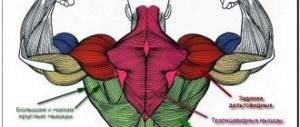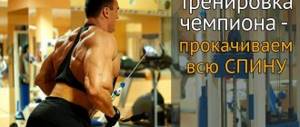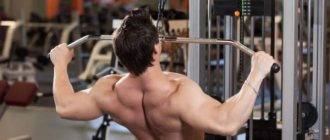Content
- 1 Strengthen your back muscles for good balance and a healthy back
- 2 How to forget about back pain
- 3 Benefits of Correct Posture
- 4 Balance support
- 5 Yoga, Tai Chi or Qigong classes
- 6 Exercises for balance
- 7 Basic Rules for Improving Back Health and Balance
- 8 Samples of complexes for back health and balance 8.1 20-minute complex
- 8.2 15-minute complex
- 8.3 10-minute complex
Strengthening your back muscles for good balance and a healthy back[edit | edit code]
Main article:
Back pain Back muscles
Many people experience back and lower back pain. As a rule, these pains are associated with incorrect posture and insufficient stability of the spine due to poorly developed supporting muscles. At the same time, poor posture worsens the sense of balance over time. As they age, more and more older people suffer from falls or the fear of falling. What begins as back pain in youth can lead to a hip fracture or the need to walk with a stick in adulthood. One in three people over 65 falls at least once a year. 25 percent of people who suffer a hip fracture over the age of fifty die within a year of it. About 50 percent of people who break their hip never regain the ability to walk normally. This data is definitely worth paying attention to! Loss of balance and poor posture don't happen overnight. This happens slowly over the years as your supporting muscles become weaker, no longer able to maintain proper posture.
Just as you need preventive measures to protect yourself from osteoporosis and muscle weakness, you need to take action now to maintain your balance in the future. A well-developed vestibular system can serve well in many sports, from mountain biking to mountaineering and ice skating. You will master the necessary movements faster, avoiding injuries that usually await people with poor balance.
Today, more and more often, health clubs offer their clients training for supporting muscles and balance exercises, including with special equipment. In this article we will present you exercises to develop a sense of balance and special devices for them. In addition, we will provide examples of excellent routines for strengthening supporting muscles and improving balance throughout the body. You can use them as needed, depending on the amount of time you have.
The role and importance of the abdominal muscles
Pumped up abs are not only beautiful, but also necessary for health, since these muscles are designed to protect internal organs.
In addition, the abdominal muscles perform the following functions:
- help the digestion process;
- allow flexion and rotation of the spine;
- take part in childbirth.
This is why they need to be trained regularly, especially for women.
It is customary to distinguish three groups of abdominal muscles:
- Direct. The appearance of the desired relief cubes depends on how well they are designed.
- Transverse. They are located deep under the straight lines and are aimed primarily at protecting the internal organs of the abdominal cavity.
- Oblique. Affects the outline of the figure.
Some girls unfairly avoid pumping up this muscle group, fearing that this will lead to the appearance of an H-shaped silhouette and the disappearance of the waist.
However, with the right approach to training, such an effect is impossible.
To pump up your abs at home, you should include several exercises in your program that will allow you to work these muscle groups and perform them regularly.
How to forget about back pain[edit | edit code]
Main articles:
Treatment of back pain, Rehabilitation for back pain
The best way to prevent these pains is to exercise your body regularly. Good body biomechanics is also important. You must be able to move correctly when sitting, standing, bending, lifting and pushing anything. After all, over time, incorrect execution of repetitive movements can lead to joint deformation and injury.
You are not at all helpless in the face of back problems. Daily and persistent struggle will sooner or later lead you to complete victory over the enemy. Even small changes over time can protect you from health-damaging pain. Let's look at the basic tips that will help you keep your back healthy and beautiful for the rest of your life.
- Exercise regularly.
With a consistent and balanced exercise program, you can become stronger and leaner while maintaining good physical condition.
- Watch your posture.
You can practice it every time you wake up and get out of bed. Of course, it’s impossible to think about your back every minute, but the more often you notice your slouch, the more successfully you can correct your posture and develop supporting muscles.
- Move correctly.
Most often, people injure their back when bending over, lifting a heavy object and turning at the same time. Therefore, try to practice the correct technique of these movements every time. Even if you just pick up a pencil from the floor, do it according to all the rules, mastering useful habits. Then, when you lift something heavy, you are much more likely to do it correctly and avoid problems.
- Control your posture at your desk.
Make sure that both in the office and at home, your desk is positioned according to ergonomic rules. Also make sure that the height and shape of the chair is suitable for your body, and that the computer is positioned so that you can maintain normal posture while working.
- Use special telephone headsets.
Many people spend a lot of time talking on the phone, keeping their necks in an awkward position. Some people also like to press the phone to their ear with their shoulder while doing other things (for example, manicure). Meanwhile, the weight of your head is between 3 and 5 kg. And if you constantly hold it incorrectly, you can significantly spoil your overall posture. Therefore, whenever possible, try to use a special headset or speakerphone, especially for long conversations.
- Walk with a backpack.
People often carry heavy travel bags on their shoulders, filling them with anything and everything. It’s better to buy a durable backpack, distribute things evenly in it, and generally try not to carry heavy weights unnecessarily.
- Buy furniture that promotes health.
Every chair or sofa you use affects your posture, especially if you sit on it frequently. Having a comfortable bed is also very important since a third of your life is spent sleeping. And if your back does not have the necessary support, this will also subsequently affect your posture. Therefore, be sure to ensure that the furniture you use promotes back health and proper posture.
The easiest way to assess your posture is to look at yourself from the side in the mirror. Ideally, you should see the following five points located on one vertical line:
Your back should reflect the natural S-curve of your spine. The presence of curves helps reduce external stress on the body, making it more elastic. Poor posture usually leads to poor balance and an increased risk of falls and injuries. Unfortunately, it can be caused by any of the factors described below.
- Muscle imbalance.
Muscles create movement by working in combination with other muscles. In a human body with correct posture, muscles exist in harmony with each other. For example, weak calf muscles usually coexist with strong calf muscles, together strengthening the back of the legs.
- Hard muscles.
These muscles often appear as a result of muscle imbalance. They increase pressure on the joints and lead to a decrease in body flexibility and range of motion.
- Long-standing injuries.
An accident in your youth, such as a broken bone or torn ligament, can permanently change your posture. A broken leg can cause one leg to be shorter than the other. Torn shoulder ligaments can result in long-term loss of mobility and reduced range of motion on one side of your body.
- Genetics.
Some abnormalities in posture can be passed on from generation to generation. For example, scoliosis, or curvature of the spine, is often inherited. Another unpleasant birth defect that affects posture can be flat feet.
Having determined the reasons for the imbalance of your posture and “knowing the enemy by sight,” you can begin a specific fight against them. If the causes lie in the muscles, begin a special exercise program to improve your posture. An excellent place to start would be to perform one of the complexes proposed in this book for the supporting muscles, specially designed for people with different abilities and levels of training. If the causes of the disorders are injuries or genetics, then your attending physician will help you choose the appropriate remedy. For example, in this case, a certain heel height, arch supports or special orthopedic shoes can help you. Whatever the state of your back health, you can always improve it. Moreover, even if you have perfect posture, it still wouldn’t hurt to train to maintain it in the future.
Among other things, wearing high-heeled shoes can lead to poor posture. Women, attention! Regular walking in heels can cause tightness and shortening of the calf muscles, lower back tension and knee pain. Therefore, you need to constantly change the height of your heel and try not to wear the same shoes two days in a row. Save your stiletto heels for when you don't need to walk a lot. Buy shoes half a size up and don't skimp on quality insoles. When choosing shoes according to the latest fashion, buy the least narrow models.
Benefits of correct posture[edit | edit code]
Read more articles:
- Posture correction
– biomechanical basis of postural disorders - Stage 1
– general recommendations for changing lifestyle and movement patterns - Stage 2
– gymnastic exercises and stretching, necessary to eliminate muscle hypertonicity and mobilize the musculoskeletal system. - Stage 3
– building strength training aimed at strengthening target muscles.
Improving your posture can change your entire life. You will not only appear taller and slimmer, but you will also feel much better, almost forgetting about back pain. Regardless of your age or fitness level, you will benefit greatly from developing good posture using the exercises in this article. Everyone needs good posture as it is important for healthy muscles, bones and injury prevention. Older adults can significantly reduce their risk of falls while enjoying a healthy, active life. Athletes will be able to improve their personal performance in sports arenas.
By training your posture, you will gain the following benefits:
- prevent or reduce the likelihood of lower back pain;
- reduce the number of injuries;
- increase the performance of joints;
- increase your range of motion;
- improve flexibility;
- get more energy.
Exercises for the abs
There are many types of abdominal crunches that can effectively pump this area without exercise equipment. We will show only one - basic - option with weighting.
Without a machine: dumbbell crunches
Lie on your back, pick up a dumbbell. Bend your legs at the hip joint and lift your feet up. Stretch your arms with the dumbbell up. Lifting your shoulder blades off the floor, gently twist your body forward and upward. Work your abdominal muscles, do not strain your neck. Then slowly lower your body onto the mat. This will amount to one repetition.
With a machine: hanging leg raises
Stand on the platforms of the machine, press your lower back to the back, grab the handles with your palms, place your forearms on the upper support platforms. Lower your legs down and “hang”, leaning on your hands. Working your abdominal muscles, smoothly lift your legs up until they are parallel to the floor. Then lower them down. This will amount to one repetition.
Combine these exercises in your workout at your discretion. The number of repetitions and sets depends on your goals (whether you are training to lose weight, gain muscle mass, or increase strength).
Balance support[edit | edit code]
In our skin, muscles, joints and tendons there are special receptor cells called proprioceptors .
. They are engaged in processing information about the position of the body during its movement in space. For example, when you walk across a grassy area, your proprioceptors tell you something like, “Okay, now I’m going to put my foot over here. The soil is loose because there is a lot of grass growing on it. The surface is slightly elastic and not entirely smooth.”
Most of these special receptors responsible for posture are located in the multifidus, the deep muscles of the lower back. The deep abdominal and back muscles are primarily responsible for your ability to maintain balance while moving. But if you don’t train them and do special exercises, sooner or later you will lose this ability. This process very accurately explains one popular expression that says: “Use it or lose it.”
With age, the proprioceptors of a person who has allowed their deep muscles to weaken become less sensitive. As a result, they send the brain less information to work with. Therefore, walking across a lawn in this state will not provide as much information about the texture and elasticity of the ground. At the same time, you are much more likely to trip on uneven surfaces. In addition, slowing reflexes, decreasing muscle strength, deteriorating vision and depth perception contribute to the weakening of the sense of balance.
Another reason why older people have poorer balance may be the fear of falling. Ironically, this fear is what increases the risk of falling. When people worry about falling, they try to compensate for their fear by maintaining a stable body position. They usually stand with their legs slightly apart or walk in small steps. However, such precautions actually only prevent a person from assessing subtle signals sent by the environment, such as information about the hardness of the ground on which he is walking, small changes in surface height, etc.
And that's not all: a poor sense of balance causes a shaky, unsteady gait. It becomes more difficult for a person to go up and down stairs, step off the edge of the sidewalk, and overcome other obstacles that he had never even thought about before. It is difficult for him to reach the top shelves of the closet, stand in public transport, in a queue, or simply in a crowd with his legs together.
Fortunately, you can reduce the impact of some of these problems or even avoid them altogether by becoming less prone to accidents. One scientific study examined the health of 110 men and women with an average age of eighty years. After three months of regular balance exercises, most subjects began to control their bodies like people 3-10 years younger than them.
Making beautiful posture
In order to increase flexibility and mobility, as well as straighten your back, making it beautiful, you can regularly do the following set of exercises:
- Pulling your knees towards your chin while lying down. To perform the exercise, you need to lie on your back and slowly raise your legs, bending your knees, pulling them towards your chin. You should freeze in this position for 10 seconds, and then smoothly return to the starting position. Do several repetitions.
- Standing against the wall, press your chin and chest. Starting position – standing facing the wall at a short distance, resting your palms at chest level. From this position, you should try to press your chest and chin against the wall, feeling the tension in your back muscles. If this condition is met, the training is considered effective for the spine.
- Bridge from a supine position (gluteal bridge). Lying on a flat surface on your back with your knees bent (as in the photo), extend your arms along your body. From this position, perform pelvic lifts, arching your back as deeply as possible. This exercise will help improve the functioning of the spine, but in addition, it is also considered effective for losing weight.
The big “plus” of the group of exercises using the Bubnovsky method is that they do not require the purchase and use of any special equipment. Moreover, according to orthopedist Bubnovsky, it is enough to perform three main types of movements to increase the capabilities of the muscular core and strengthen the back, which he talks about in the video.
At the same time, you can get dumbbells that will help you strengthen your back muscles and lose weight in this area. By performing back exercises with dumbbells, which the instructor talks about in the following video, you can improve your overall health, because they are designed to activate all body systems.
To summarize, one cannot fail to note the positive trends in physical therapy in patients who suffered from various diseases of the musculoskeletal system. Even those for whom surgical interventions were contraindicated were healed thanks to similar sets of kinesitherapy exercises.
Yoga, tai chi or qigong classes[edit | edit code]
Rice.
1. Tree yoga pose: level 1 (A), level 2 (B), level 3 (B) The ancient practices of hatha yoga, tai chi and qigong, which came to us from India and China, are based on the cultural traditions of these countries. For a long time they have been the path to achieving physical, mental and spiritual health and balance in the human body. Having subjected these practices to rigorous scientific analysis, numerous modern studies have fully confirmed their benefits and effectiveness.
All these ancient systems of self-development are suitable for both young people and old people. However, they are especially attractive for older people because they involve slow and calm exercise. Additionally, while many Americans enjoy more vigorous movements, these techniques can be adapted to suit people of varying fitness levels and abilities. In particular, an excellent example of one yoga pose with different levels of difficulty is shown in Fig. 1 A, B and C.
Balance exercises[edit | edit code]
Main article:
Balance and stability exercises
You can completely improve your vestibular system by practicing not only oriental gymnastics, but also special balance exercises. Whatever approach you prefer, everything will be beneficial. The main secret is to choose movements that you enjoy and that motivate you to practice regularly.
We believe that balance exercises, such as those listed later in this section, are best taught individually or in small groups. In this case, you should be supervised by a trainer or doctor who has extensive experience and deep knowledge in the field of anatomy and body correction. You can practice them yourself.
Always remember that in balance exercises, the main thing is not quantity, but quality. You must focus completely on the movements you are performing and not get discouraged if something doesn’t work out at first. For example, walking on a real or imaginary log (Fig. 2) requires constant correction of the position of the knee, hip and head. All your muscles from the top of your head to your toes should work in unison. This promotes smooth movements without unnecessary arm swings and falls. It will be difficult at first, but after a couple of lessons you will be able to perform this exercise masterfully. Over time, such activities will awaken your reflexes and increase your understanding and control of your body on a subconscious level. All this translates into improving not only your posture, but also the efficiency of your movements.
Try to perform these exercises two or three times a week at the end of your regular strength training routine. Start with one approach and gradually increase their number to three. If you feel like you need to spend more time focusing on balance, add a couple extra sessions per week to these exercises. At first, this training may seem quite difficult. At first, after too intense exercise, you may feel extremely tired and even experience pain in your muscles. Therefore, even if you know a lot of balance exercises, do no more than four at a time.
Rice. 2. Place one foot straight in front of the other and try to sway as little as possible.
- Walking on a log.
Walk slowly along the low, reinforced wooden log. Maintain a straight posture, pointing your knees exclusively forward and freely lowering your arms along your body. In the absence of a log, you can draw a straight line 2-3.5 m long on the floor with chalk and walk along it. Place one foot directly in front of the other and try to avoid swinging or swinging your arms as much as possible. If you fall off a log or go off the line, simply return to the place where you left off and continue on your way (Fig. 2).
Focus your gaze on the end of the log: this will help you maintain your balance better.
An easier option.
Extend your arms out to the sides exactly as far as necessary. Make three passes back and forth.
A heavier option.
Walk backwards along the log.
- “Fulcrum point.”
Lower your arms freely along your body, stand on one leg, and stretch the other behind you and lift it a few centimeters above the floor. Lean slightly forward and hold this position for one minute. Then slowly return your leg to the floor and repeat the exercise with your other leg extended. Do 3 to 5 repetitions for each leg.
An easier option.
Rest your fingertips lightly on a wall, chair, or other stable object.
Rice.
3. Try to maintain your balance for up to one minute . A more difficult option.
Bend your torso a few centimeters lower. When you get good at this, bend over so that your upper body is almost perpendicular to the floor (Fig. 3).
- "Ostrich".
Lower your arms freely along your body, stand on one leg, bend the other at the knee and lift it in front of you a few centimeters above the floor. Maintain this body position for a minute. Then slowly place the bent leg back on the floor and repeat the exercise by lifting the other leg. Do 3 to 5 repetitions for each leg.
An easier option.
Rest your fingertips lightly on a wall, chair, or other stable object.
A more complex option.
Try this exercise with your eyes closed.
Features of the structure of the hands
It is possible to make your shoulders and forearms beautiful and toned by working the following muscles:
- biceps, the main purposes of which are to bend the arm, rotate the forearms, and prevent dislocation of the shoulder joint;
- triceps - the mirror muscle of the triceps biceps, helping to extend the arm at the elbow;
- forearm muscles - they bend the elbows and help rotate the wrists and forearms.
It is these muscles that receive the most attention during the training process.
Basic rules for improving back health and balance[edit | edit code]
Support muscle training is different from strength training. The following tips will help you make your classes as effective as possible.
- Always allow time for warming up.
Since support and balance training is not very long, warming up can be part of it. Active exercises that warm up the muscles well include lunges and squats (one-leg squats are especially useful). Push-ups are also effective. The main thing is not to do the exercises as hard as you can, but work at a calm pace suitable for warming up.
- Focus on muscle endurance.
To strengthen the supporting muscles, it is very important to increase muscular endurance. Depending on the complexity of the exercise, perform it 12-20 times. If time permits, do 2-3 approaches.
- Take 30 second breaks.
The rest period should be short, since the main thing here is to develop muscle endurance.
- Keep an eye on your technique.
Do not continue working if you are tired and can no longer perform the exercise correctly. Since these exercises are designed to improve the efficiency of movements, their correctness is very important with each repetition.
- Listen to your body.
You must be very careful to avoid any strain on the muscles in your lower back or neck. Listen to the signals your body is giving you. If certain exercises cause you pain, just don't do them. If you have any back problems, follow the recommendations of your doctor or personal trainer.
- Always stretch.
You can stretch both after specific exercises during rest, and at the very end of the workout. Meanwhile, in any case, do not forget about stretching to develop muscle balance, increase your flexibility and ease of movement.
Warm up before training
It is very important to do a joint warm-up before each physical therapy session. This will prevent injury and warm up the muscles. Here is an approximate warm-up algorithm:
- Starting position: standing, feet shoulder-width apart. Take a deep breath, stand on your toes and stretch your arms up, while trying to stretch your spine as much as possible.
- Without changing your position, try to bend down as low as possible, reaching your fingertips to the floor.
- Extend one arm above your head and slowly stretch to the right, then to the left. Repeat with the other hand.
- Stretch your arms out to the sides parallel to the floor, bend your elbows slightly. Perform rotational rotations to stretch the shoulder joints.
- From the initial standing position, with a straight back (make sure that your shoulders do not drop down or slouch), make a deep, slow lunge forward, first with one leg, then with the other. This movement will help stretch your hip joints.
Samples of complexes for back health and balance[edit | edit code]
In this section we will offer you several complexes that will prevent back pain, help improve posture and maintain a sense of balance throughout your life.
20-minute complex[edit | edit code]
For this complex you will need a gymnastics mat or rug, a large ball and an expander. If you don't have a ball, you can do the exercises without it. The main thing is to strictly follow the sequence of exercises suggested in the table. 1 and 2.
Table 1. Complex with a mat, ball and expander
| Warming up | Squats, lunges |
| Balance exercise | "Ostrich" |
| Back | Lat row with expander |
Table 2. Complex for supporting muscles
| Small of the back | Lowering the pelvis, stretching the back on the ball |
| Stomach | Twisting on the ball |
| Supporting muscles | Support, stabilization of the back with alternation of all four limbs |
| Stretches | Cat stretch, quadriceps stretch, biceps stretch, pretzel stretch, uplift, hands behind back stretch |
15-minute complex[edit | edit code]
If you spend 15 minutes on your supporting muscles at least three times a week, your posture and balance will improve significantly over time. Don't think that an effective workout has to be long and hard. Sometimes a small session can be several times more effective than a multi-hour session. For example, try to perform the complex presented in table. 3.
Table 3. Complex with mat and ball
| Warming up | Pelvic lowering, leg extension, ball march, ball push-up |
| Back | Back stretch on the ball |
| Stomach | Ball crunch, diagonal ball crunch |
| Supporting muscles | Ball support |
| Stretches | Cat stretch, quadriceps stretch, biceps stretch, pretzel stretch, uplift, hands behind back stretch |
10-minute complex[edit | edit code]
Even if you feel like you don't have any time, it's better to do something than nothing at all. You can perform a small ten-minute complex at least every day. You can even develop a good and healthy habit of doing it in the morning, as soon as you get out of bed, or before going to bed. An excellent example of such a complex is presented in table. 4.
Table 4. Mini-complex for the back
| Warming up | Lowering the pelvis, stretching the legs |
| Supporting muscles | Support, lateral support, reverse support |
| Stretches | Cat stretch, quadriceps stretch, biceps stretch, pretzel stretch, uplift, hands behind back stretch |
How to get rid of lower back pain?
If you're familiar with the feeling of tightness in your lower back in the morning and want to learn how to strengthen your back at home, these exercises will help restore flexibility and increase mobility in your body, reducing pain and discomfort. To reduce the likelihood of such cases, try to go to bed on time and get enough sleep in a comfortable position.
1. Lying on your back, pull both knees toward your chest while bending your head forward as far as is comfortable.
2. Lying on your back with your knees bent and your heels on the floor, place both hands behind one knee and pull it toward your chest.3. The most common exercise is while standing, simply bend down without bending your knees. Try to touch your toes with your hands, but don't strain.
We recommend that you read: Causes of swelling in the legs and methods for eliminating them











